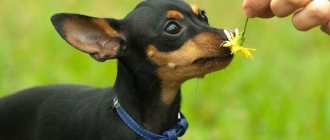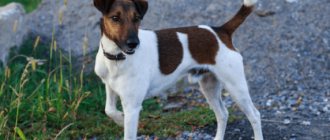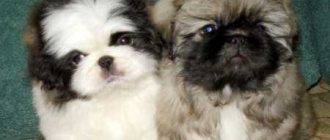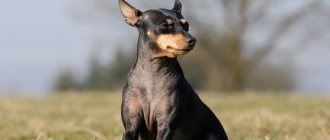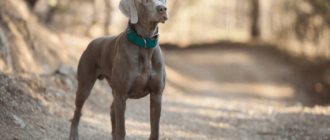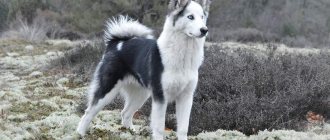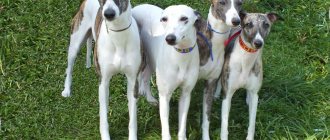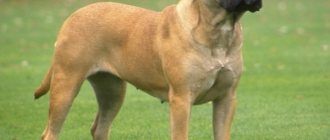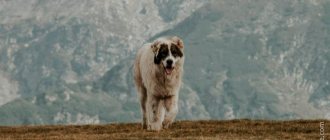Breed characteristics
| Short description | |
| Origin: | Belgium |
| Conditions of detention: | In an apartment, in a house without a garden |
| Purpose: | Companion dog, rat-catcher dog, decorative dog |
| Color: | Black, charcoal, black-red |
| Wool length: | Average |
| Adult dog size: | Height 26-32 cm, weight approximately 3-6 kg |
| Average life expectancy: | 13-15 years old |
| Walk: | Need a 2-time walk |
| Physical activity needs: | Average physical activity needs (walking 1 to 3 hours per day) |
| Fédération Cynologique Internationale (FIC) classification: | Group 9: Toy and Companion Dogs, Section 3: Small Belgian Dogs |
| Puppy price: | 10000-30000 rubles |
Education and training
Due to the fact that the Griffon is a very sociable and inquisitive dog, raising and training it is quite simple. He gets involved in the process with great pleasure and explores new horizons.
It is strictly not recommended to raise such a pet by locking it in an enclosure or cage, as you will end up with an apathetic and lethargic animal. Griffon needs to be picked up often, told how sweet and good he is, and how much you love him. Constantly showing affection for your little friend will strengthen his loyalty.
Home loneliness needs to be cultivated gradually. It is strictly not recommended to immediately leave the baby alone for a long time, as he may think that he has been abandoned. An equally important point in education is haircut and trimming. They are also taught this from a tender age.
Of course, the griffon must also be taught basic commands. If you are not confident in your abilities, this painstaking “task” can be entrusted to professional dog handlers. However, usually even inexperienced owners successfully cope with the training process.
If you don’t let everything take its course and strictly follow the recommendations of famous dog breeders, then a small and funny pet will grow into a true, loyal friend and ally.
History of the origin of the species
Griffons cannot be called a new breed; they arose approximately 500-600 years ago. The Belgian appeared a little later than other small dogs, but quickly fell in love with the nobility and, already from the 15th century, showed off at receptions as an accessory for noble ladies. This is evidenced by canvases with portraits of kings and the bourgeoisie: “Cita Arnolfini” and “Portrait of Henry III”.
Most likely, Brussels small dogs and pugs participated in the creation of the Belgian Griffon. Close relatives are also considered Yorkshire Terriers, Affen Pinschers and Kalikov Schnauzers. The very first dog to give birth is considered to be a stray bearded one called “Smoothie”.
This dog was the favorite of Draga Obrenovic, the queen of Serbia in the late 19th and early 20th centuries. Thanks to the griffon, Draga remained alive after poisoning, because she first gave all her food to the pet to try.
In addition to aristocrats, ordinary people also got Belgian small dogs. Griffons have a good sense of smell, hearing and high activity. That is why they were used as mousecatchers in stables and barns.
In 1880, the breed was first demonstrated at the Brussels Exhibition. Breeders became interested in the characteristics of the dog and began actively working on its qualities. After numerous crossings, three species appeared: Belgian, Brussels and Brabant. They differed in the length and density of their fur, the shape of their muzzle and their color.
Oddly enough, the breed has gained popularity in many European countries, except Belgium itself. These dogs were imported to both Italy and France. In Russia, Belgian Griffons appeared only towards the end of the 20th century .
The breed was officially registered in 1904 . The last amendment to the classification was in 2003 . The three breeds are recorded as different species, but the characteristics are the same for all, except for the quality of the coat.
History of the breed
According to experts, the griffon is a dog that first appeared in Belgium. It was introduced to the world in 1880. Today, these indoor animals are known both in Russia and in Western countries.
The Brussels Griffon is a very active and joyful dog.
For your information! The Griffon dog breed has similar genetically similar brothers in the form of Pinschers. Although it is still not clear who came from whom.
The original purpose of small dogs was not very noble. In fact, they caught rats and other small rodents. The dogs were most often kept in warehouse areas, where they were useful.
Much later, when the Brussels Griffon appeared in the houses of the nobility, this breed received an official aristocratic title. Gradually, representatives of this breed began to disperse throughout the world. In Russia they did not take root so readily, and there are no separate stories about them.
Distinctive features
Small Belgian dogs are similar in their body structure: almost square in shape (length equal to the height at the withers), strong skeleton, flat, funny muzzle. Height – 26-32 cm, weight 3-6 kg, parameters are not divided by pet’s gender and subspecies.
A special characteristic feature can be considered a bald head and a long thick beard. This makes the griffon look like an old man, giving sternness and wisdom to their appearance.
Breeding of the breed is meticulous. All dogs that do not meet the standards are excluded from the breeding lists so as not to spread the defects to the next offspring. Griffons with increased aggressiveness, modesty, or body deformations that do not correspond to their size may be considered “defective” and transferred to the pet class (pets).
Main features of the breed:
- The head is much larger than the body and has a characteristic spherical shape. The stop is strongly pronounced and the forehead is rounded. The muzzle is flat (no more than 1.5 cm in length), slightly longer for Brabançon. The jaw is wide, the teeth are small, the bite is of the “overshot” type (the lower jaw overlaps the upper jaw). The mouth is tightly closed (neither fangs nor tongue are shown). The lips are black, not jagged.
- The nose is only black, upturned, flat (the line of the forehead, chin and nose are almost in the same plane), located at eye level.
- The eyes are wide-set, round, large. The color of the iris is dark brown. Open white of the eye is unacceptable.
- The ears are small, set high and wide. Can be cropped; undocked ears are also acceptable (in which case the ears hang in triangles).
- The body is predominantly square in shape with a strong skeleton. The withers are raised, the loin is wide and muscular. The croup is slightly sloping. The chest is quite deep, the ribs are flattened. The stomach is tucked.
- The tail is usually shortened (2/3 of the length). Set either high or at the level of the lumbar line. Aims upward. A curly tail is not acceptable, only straight, short hair.
- The limbs are parallel , strong, widely set, the hind limbs are slightly longer than the front. The hock and knee joints are well developed. The paw pads are round, black, tightly compressed.
- The coat of the Belgian and Brussels Griffons is uneven, hard, wavy, long with a good undercoat. Silkyness and excessive curliness are not allowed. A thick beard grows on the muzzle (from the nose, spreading to the ears). The Brabant has a short coat (1-2 cm), flat and shiny.
- Belgian color: black, tan, black-brown. Brussels : red, sandy. Brabant : black, red, and red.
Description of the breed
In proportion to its size, the Griffon should be heavy in weight, indicating strong bone and powerful muscles concentrated around a small circumference. This strong and compact dog should never come across as rude.
- The head of the griffon should be large relative to the body. In the wire-haired variety, the rather coarse hair on the skull extends to the muzzle and chin, forming a beard, which gives these small creatures a special, unforgettable attractiveness.
- The head is without a doubt one of the most characteristic features of the breed, and in old sources the special features are described as an "almost human expression" - there is no better way to say it! The skull is not as flattened as that of the Pekingese, but less domed than that of the King Charles Spaniel. It is the slightly rounded skull with a rounding in the temporal region that accentuates the special expression that distinguishes the breed.
- A black nose should have wide open nostrils, which eliminates breathing difficulties. When viewed from the front, the tip of the nose should be level with the center of the eyes. The eyes are very dark, large, round, clear and alert. A black edging around the eyes is desirable, but this sign, unfortunately, is not so common.
- The griffon's muzzle is wide; neat lips are characterized by a straight closure, with the lower lip protruding only slightly, giving the muzzle an “upturned” appearance, which is emphasized by a prominent chin.
- The physical characteristics of the breed also include a rather powerful chest, which determines the wide stance of the straight forelimbs.
- The hind limbs are distinguished by well-defined muscles and, with a typical structure, provide a strong push.
- The griffon's ears should be semi-erect, slightly rising above the level of the skull, and the canopy should fall straight forward, covering the erect part. Within the breed, the shape of the ears is characterized by quite a wide variety and takes into account only the criterion of size - the smaller they are, the better.
The weight range of these small dogs is quite wide - from 2.2 kg to 5 kg; Preference, of course, is given to individuals of average weight within these limits. However, even small dogs have a greater weight in proportion to their size than appears at first glance. Sometimes tall griffons have less weight than small, squat individuals, which is explained by the heavy bones of the latter.
In Britain, all Brussels Griffons are divided into two varieties: wire-haired and smooth-haired.
Smooth-haired dogs have short, dense hair that should not feel silky to the touch. Some individuals have a very thick undercoat, forming a mane and a bustle. This variety is also distinguished by longer hair on the shoulders.
The Wirehaired Griffon has a coarse coat, and in rare cases it even resembles wire, such as that of the Fox Terrier. Curl is excluded, but some dogs with very coarse coats and very thick undercoat tend to have a slight curl. Not all individuals have an undercoat, but its presence is nevertheless welcome. To improve the texture of the coat, these dogs need manual trimming.
We advise you to read: Doberman Dog Breed
Unlike smooth-haired individuals, wire-haired griffons are characterized by the absence of seasonal molting. In this variety, each hair grows to a length of 7-10 cm, and then dies, and a new one grows in this follicle.
From the point of view of the standard, show-class griffons must have bright red, black or black and tan colors with the complete absence of any white markings. As for pet-class dogs, the choice of color depends entirely on the tastes of the owner.
According to the standard, the red color ranges from dark mahogany to fiery red and fawn, in which case the shade is of little importance to breeders and experts. However, it is still worth noting that the fawn color must have a reddish tone, since otherwise, from the point of view of an expert, the color may be considered defective. In individuals of bright red shades, a darker mask and similar ears are desirable, but this feature is more typical of the smooth-haired variety.
The black coat should be characterized by a deep color, however, young dogs very often have a rusty tint or even a silvery undercoat. It is typical for black griffons to have excess hair on both the outer and inner sides of the ear, so special attention should be paid to these areas when grooming.
These days, the black and tan griffon variety is quite rare. Previously, these dogs were more popular, and the first champion in this color won his crown in 1930, but the next black and tan griffon did not become champion until 21 years later.
Unlike most other dog breeds with a similar type of bite, the Griffon's tongue and teeth should not be visible. A slight undershot as a breed characteristic suggests that the lower teeth protrude just slightly forward relative to the upper teeth, and this jaw structure gives this small dog the characteristic expression that distinguishes the breed.
Photo of an adult dog
Character
Brussels Griffons are not a typical decorative dog; their character is closer to terriers. This is an energetic and active little dog that takes itself seriously. All representatives of the breed will be excellent companions, but only in the right hands.
They form strong relationships with the owner, the downside of which is attachment only to him, and not to all family members. It will take a lot of time and effort before a second person (even if it is a spouse) can gain the trust of a small dog.
Despite their confidence and attractiveness, they feel most comfortable in the company of a loved one.
They do not tolerate loneliness well and feel sad while their owner is not at home. Puppies need socialization to be confident and polite around strangers, but even the best-behaved griffons remain aloof around them.
Those dogs that have not been socialized will be fearful or aggressive, although they bark more than they bite.
Most experts do not recommend small Brussels dogs as family dogs, some strongly do not. Not recommended for families with small children, although they can get along great with older children.
They could have been good watchdogs, if not for their size. However, they are observant and will always raise their voice if something goes wrong.
Much like terriers, Brussels Griffons differ from them in their level of aggression towards other animals. Most accept other dogs calmly and are even happy to have company. However, they still prefer the company of people and suffer from dominance. They love to be at the head of the pack and will take the place of leader if given the opportunity.
They also love to perform loudly, in the presence of other people's dogs. Although this behavior is more noisy than aggressive, it can be annoying for large dogs.
Many Brussels Griffons are also greedy for toys and food.
Avid rat catchers in the last century, today they rarely chase other animals.
In most cases, they bother cats much less than other similar breeds.
Belgian dogs are quite smart and can successfully perform in obedience and agility. Some owners teach them tricks, but training them is not so easy. They are stubborn, disobedient, dominant and often challenge the role of humans in the pack.
In order for the owner to manage this dog, he must assume a leadership role and be aware of this at all times. Yes, you can train them, but it will take more time and effort than with other breeds.
Brussels Griffons are one of the most energetic and active of all decorative breeds.
This is not a dog that will be satisfied with a short daily walk; owners will have to find time for additional activity. They love fairly long walks and run around without a leash.
In addition, they love to run around the house and can do it without getting tired. If you are looking for a calm dog, then this is clearly not the case. If you can't stress her enough, she will find entertainment and it will become a nightmare for you.
These are well-known mischief makers; they often need to be taken out of places where they managed to get into, but they cannot get out.
They love to get into problems to satisfy their curiosity. This should not be forgotten and left unattended for a long time.
In general, they are well suited for apartment living, but there is one circumstance that is important to be aware of. They bark a lot, and their barking is loud and often unpleasant.
Socialization and training reduces the noise level, but does not eliminate it completely. If the Brussels Griffon lives in an apartment and is bored, then he may bark incessantly.
Most behavior problems in toy breeds are a result of small dog syndrome. Small dog syndrome occurs in dogs whose owners behave differently than they would with a large dog.
They do not correct incorrect behavior for a variety of reasons, most of which are perceptual.
They find it funny when a one-kilogram Brussels dog growls and bites, but dangerous if a bull terrier does the same.
This is why most Chihuahuas break off the leash and attack other dogs, while very few Bull Terriers do the same. Dogs with small dog syndrome become aggressive, dominant, and generally uncontrollable.
Photos of puppies
Features of character and behavior
Initially, the Belgian Griffon was called a black wire-haired terrier, and for good reason. This little decorative dog really gets along with an active, playful and slightly wayward dog.
They love to growl, bark, dig and play. But they are kind to people and do not show aggression. They are considered good family pets.
Advantages
- This dog is one of the rare ones, especially in Russia. Her unique appearance will attract the attention of passersby.
- The originality of the breed can definitely be considered a plus . In addition, the breeder has a choice among three subspecies; he only needs to decide on the length of the coat and color, otherwise the dogs are identical.
- The character of the Belgian Griffon allows absolutely everyone to turn him on . Good nature, sincerity, devotion to the owner are his main features. He gets along well with children and loves to play and spend time with his family.
- The griffon also adapts to the pace of life of the breeder and feels all his emotional changes. He will never bother a person if he feels emanating negative energy or fatigue.
Despite the fact that the Belgian Griffon loves all family members, he will obey only one - the one whom he considers the owner - the leader.
- This breed has long been used as a farm guard against rodents. Griffons have acute hearing and sense of smell, they will guard the home and warn if they notice a stranger. They are usually tolerant of others, often even hide behind their owners, and do not show aggression (strong nervous system and balance).
- They get along well with other pets.
- They learn quickly, are not lazy and are smart. They follow the owner everywhere and do not think about his instructions. Thanks to their good abilities, they understand at a glance; griffons do not need to be persuaded or explain something to them for too long. They are hardy, not pampered, and tolerate both cold and heat well.
Easy to care for and maintain, suitable for beginners. Not prone to genetic diseases. Fairly clean.
Flaws
- Griffons, in particular Belgian ones, have a hard time with loneliness . They need a lot of attention. You cannot leave the dog alone in the apartment for a long time, he will begin to get bored, sad, and in the worst case, he will find something interesting to do and ruin the furniture, clothes, and carpets.
- They need to be walked . It is impossible to make a lap dog out of Griffon; he does not learn to go to the toilet on a tray or newspaper. At least 1 hour a day should be spent jogging and walking.
- The originality of the Belgian Griffon can play a cruel joke. Sexually mature dogs need a release, and searching for such dogs takes a lot of time, because not every city has representatives.
Character of the Brussels Griffon
The character of the Brussels Griffon is largely determined by the fact that these dogs are partly terriers. This means that they are completely devoted to their owners. Wherever their master goes, the Brussels griffin will follow him everywhere.
The Brussels Griffon is more of a constant companion than a family pet. Dogs of this breed need constant contact with their owner and do not tolerate loneliness very well. Therefore, it is better not to get such a dog for people who are not ready to spend a lot of time next to their pet or do not have such an opportunity.
One of the reasons for the Brussels Griffon's dependence lies in its sensitive nature. These dogs are not overly fearful or aggressive and are often quite complacent and spoiled when over-pampered. However, they need consistency and a stable environment in order to feel good and be happy.
Brussels griffins in
Due to their temperament, they do not do very well as family pets, especially when there are very young children in the family. These dogs love to be surrounded by constant attention, but if they overdo it, they can become capricious. Those who spend a lot of time with the Brussels Griffon have a good sense of how much attention and love their pet needs and how much is unnecessary.
Socialization helps when passers-by want to take a closer look at the dog or even pet it. In this case, the Brussels Griffon may become frightened of a stranger and suddenly rush at him. Socialization at an early age can help minimize this behavior. Also, politely requesting that strangers not touch the dog can help in this situation.
We advise you to read: Dog breed Hortaya Greyhound
In general, Brussels Griffons rely on their owner. Not particularly aggressive, they can be shy around new people and get confused in unfamiliar situations. Although Brussels Griffons will bark when the doorbell rings, this breed is not prone to barking during the day or night. They prefer calm and avoid confrontation for the most part.
Care and maintenance
Representatives of this breed are unpretentious. They get along well in an apartment and do not need particularly long walks or frequent physical activity. Before buying a puppy, you need to determine a place for it: buy a bed, bowls with adjustable height, toys. The room should not be too hot or cold.
The coat of the Belgian Griffon deserves special attention. It is not as soft as York, but requires special care. In addition, it is important to monitor your pet’s diet and routine.
Nutrition
The diet of griffons is no different from that of other breeds. They also need all the useful elements:
- Proteins (lean meat of beef, chicken, rabbit, turkey, raw and boiled; fermented milk products; eggs);
- Carbohydrates (cereals, vegetables, fruits, cereals: rice, buckwheat, wheat);
- Fats (sea boiled fish).
It is possible to feed with dry ready-made food, in this case it is recommended to buy only premium food . It is not recommended to mix natural food and offal.
Your dog needs all the vitamins and minerals. It is important to consult with a veterinarian and determine the combination of medications your pet needs.
You cannot feed your Belgian Griffon with table scraps. Human food is absolutely not suitable for dogs, and especially for small breeds. It is highly not recommended to give spicy, fatty, fried, flour, sweet and salty foods. Bones are considered a dangerous product: sharp, large or hard bones can seriously damage the stomach and digestive tract.
- The serving size for a pet is calculated using a certain formula: 20% of the dog’s weight . Feeding frequency – 2 times a day . For puppies – 4 times . The bowl should be placed parallel to the height of the Griffon's chest.
- Don't forget to drink. A container of clean water should always be in the public domain. When walking in summer, it is recommended to take a bottle and drinking bowl.
Health
- Due to the uncertainty surrounding the griffon's ancestry, it is very difficult to determine their genetic weaknesses. In general, this dog is not particularly sickly, with strong immunity and health. In any case, this breed is considered a long-liver (13-15 years, the oldest is 20 years).
- There are a number of diseases that are often found in Belgian Griffons. However, with proper care and, if necessary, treatment, the pet is not in danger.
Vaccinations
Vaccination is required for all domestic dogs. It provides immunity from dangerous infectious and viral diseases. Usually the cost of vaccination does not exceed 1000 rubles, but this depends on the drug.
Before the procedure itself, it is necessary to cleanse the pet’s body of worms and other parasites using special tablets (purchased at a pet store). You also need to maintain home care, because puppies are most susceptible to dangerous bacteria. After vaccination, it is important to provide the griffon with an incubation period (14-15 days).
There are two types of basic vaccinations for dogs:
- Complex vaccination (enteritis, leptospirosis, para-influenza, plague) is done at 1.5, 2.5, 6, 12 months consistently and is updated every year.
- Rabies vaccination is required for export abroad ; the puppy is vaccinated at 7 months and annually thereafter.
All procedures are carried out in veterinary clinics by specialists. It is also necessary to obtain a veterinary passport - the main document of the pet. All medications that your dog has taken or is taking, in particular, anthelmintics and flea medications, will be entered there.
Diseases
Representatives of this breed are characterized by several classifications of diseases:
- Eye diseases: extra eyelashes, conjunctivitis, loss of eyeballs (weak eye muscles), cataracts, problems with the eyes;
- Dislocations of the kneecaps (most often due to unscrupulous breeders and poor conditions for keeping the puppy);
- Viral and infectious diseases (if all vaccinations are available, the risks are reduced to 10-15%);
- Parasites (both intestinal and cutaneous);
- Difficult pregnancy and childbirth (due to the small size, it is sometimes difficult for a female to bear and give birth to healthy puppies, veterinarians help with this).
Since these dogs are not particularly prone to various health problems, it is important for the owner to monitor the pet (feeding, coat) and the likelihood of losing the animal will decrease.
Walk
- This breed is quite active. Physical activity is important to them: games, jogging, training. Of course, 10-20 minutes a couple of times a day is enough for a “walk”, but then all the main physical activity of the pet will take place in the apartment.
- With insufficient walks, Belgian Griffons begin to feel sad ; breeders claim that the lack of fresh air negatively affects the life expectancy of these dogs.
- The best option would be joint tourist trips , morning and evening jogging. Sometimes even the most banal shopping trip can become a real adventure for a griffon.
- For walking, you should choose a harness and tape measure. Leashes and collars are not recommended: due to its small size, such a dog can be strangled. You can only release it when the pet knows the basic commands and is accustomed to walking next to its owner. Otherwise, he may run away.
It is important to let your pet communicate with the outside world: sniff the ground, other dogs, people. However, you should watch what your pet chews and licks.
Grooming
The Belgian Griffon's coat is hard and thick. Despite this, they do not shed or emit unpleasant odors. However, because of this, the dog needs to be trimmed (plucked) 2-3 times a year to remove old fur, this is especially important during seasonal shedding.
- There is no need to cut your pet's hair (except for the areas around the eyes).
- In addition, it is important to comb the animal free of debris using soft brushes 2-3 times a week . Using a stiff brush – 3-4 times a month. Bathing is allowed no more than once every 3 months (only with the help of special shampoos).
- The griffon's claws need to be trimmed every 2-3 weeks so that they do not wear down during walks. Carefully monitor the condition of your eyes, ears and nose. If possible, clean every 2-3 days .
- Particular attention is paid to the beard : after each meal, it is necessary to wash the coat and comb it so that individual hairs do not stick together and dry out.
- After walks, you need to wash your paws and clean the pads of small debris.
Video
* We invite you to watch a video about the Belgian Griffon . In fact, in front of you is a playlist in which you can select and watch any of 20 videos about a given dog breed by simply clicking on the button in the upper right corner of the window. In addition, the material contains quite a lot of photos. By looking at them you can find out what a Belgian Griffon looks like.
In this article:
|
Rate the material!
[Total votes: 5 Average: 4.2]
Mating
Experienced breeders know that dogs become sexually mature at 12-14 months of life , but animals cannot be bred that early, because they are not yet able to conceive and bear offspring.
- Usually, bitches are brought on their 3rd heat (15-17 days from the start) . It is important to choose a male that is slightly smaller in size than the female, so that the puppies are not too large for her body.
- For the first time, you can contact a specialist . He will tell you what to do and help the dogs during the act.
- The pets are walked together, most often on an empty stomach, and then taken to the dog’s territory. Usually animals behave actively: sniffing, flirting. If there is no such reaction, then it is possible that the dogs do not perceive each other.
- During the process, the male is helped to find a comfortable position and the girl is held. After the “lock” has occurred, the pets are not released for another 30-40 minutes . Repeated mating is carried out after 2 days.
Mating dates
Mating of dogs is carried out in accordance with the Regulations of the RKF. According to the document, male dogs can be bred at 13 months of age, and females at 15 months of age. Breeders also adhere to these deadlines, since healthy puppies can only be expected from a strong and healthy parent pair.
It is not allowed to breed a Griffon after the first heat. The waiting time may be lengthy, but it is worth waiting until the bitch’s body is ready to bear offspring. Pregnancy and childbirth take a lot of strength and energy from griffons , and part of their health is also lost.
A griffon's third without any disturbances indicates absolute health in the dog's genital area. You can prepare directly for the mating itself. Before the intended mating, before the start of the Brabançon's estrus, the coat is treated against parasites, prevented from worms, and vaccinated. A contraindication to bearing offspring is the bitch's excess weight, which also complicates the fertilization process. Therefore, it is necessary to monitor your pet’s nutrition and carry out vegetable fasting days.
Key points in training
First of all, puppies are taught their name, a place to sleep, eat and a primary toilet (before walking). After that, learn the basic commands:
- "Place";
- "It is forbidden";
- "Near";
- "Sit";
- "Voice".
At the discretion of the trainer, the list is expanded. Belgian Griffons are very smart and, despite some waywardness, they always obey their owner. They learn quickly and pick up what the breeder likes and what they don't.
Thanks to these qualities, griffons are good at agility and happily overcome all obstacles together with a person. There is no need to use brute force; these dogs understand everything almost without words.
Read about how to properly train a dog in the article: “Training a puppy: effective methods from dog handlers, learning commands at home.”
a brief description of
The Belgian Griffon is a small dog that appeared in the vastness of Belgium as a result of crossing a pug with a Brussels Griffon. Some believe that the toy terrier also took part in the appearance of the breed.
This breed was officially recognized at the beginning of the 20th century, however, during the world wars it almost completely disappeared. It was a miracle that it was preserved, but it was not possible to regain its former popularity.
To this day, Belgians are among the rarest breeds in the world.
They are very smart, quick-witted, energetic and always have a positive attitude; they practically never have periods of blues. They have a balanced character and do not like to bark. They love to explore new horizons, are always open to learning and enjoy learning new commands. With such a pet it is easy and comfortable.
How to choose a puppy
Before buying a puppy, you need to make sure you have free time and opportunities to raise and maintain a dog of this breed . You need to consult with experts and read reviews. After the final decision, you need to decide where to buy a pet. This can be done from professional breeders (clubs, nurseries) or “from the hands” of ordinary people. The second option will be much cheaper, but there can be no confidence in good health and the presence of all documents.
If you purchase from an official club, first of all, you need to call a legal or physical person, find out everything about the puppies (keeping conditions, age, feeding) and ask for at least one of the parents. It is important to learn about birth diseases, weaknesses of the body and skeleton.
After official conversations, you need to look at the dogs themselves: puppies must meet standards and be well-groomed, joyful, clean and curious. In good clubs, newborn dogs undergo all the necessary primary procedures: deworming, first vaccinations, obtaining a passport and pedigree. After purchasing a pet, you need to maintain contact with the breeder so that if you have any questions, you can resolve everything.
The cost of the Belgian Griffon varies from 8,000 rubles to 30,000 rubles. Lowest price: representatives of the pet class from an unofficial club or breeder (sites selling dogs in Russian cities).
Belgian Griffons are definitely the sweetest and kindest decorative dogs, in which both a playful terrier and a brave guard dog coexist. They will be devoted to their family with all their hearts and will be with their owner every minute of his life.
Health, typical diseases
Griffons are long-livers, because they live 12-15 years. They are distinguished by enviable health and strong immunity. These babies successfully resist viruses and colds; the owner’s main task is to carry out vaccinations and treatment against parasites in a timely manner. However, veterinarians note a number of specific diseases characteristic of representatives of the griffon breed.
The most commonly diagnosed pathologies in griffons include:
- ophthalmological problems (eyeball loss, cataracts, retinal dystrophy, deformation of eyelashes, etc.);
- deformation of the respiratory tract due to anatomical features - narrow nostrils, upturned nose;
- complications during childbirth.
Among the hereditary diseases of griffons, one can highlight retention of baby teeth, wolf claw, eclampsia, reverse sneezing syndrome, lacrimation, and unilateral cryptorchidism. Responsible breeders do not allow sick animals to be bred.
In addition, Griffon puppies begin to be sold no earlier than three months. By this age, you can be sure that children have not inherited dangerous pathologies.

